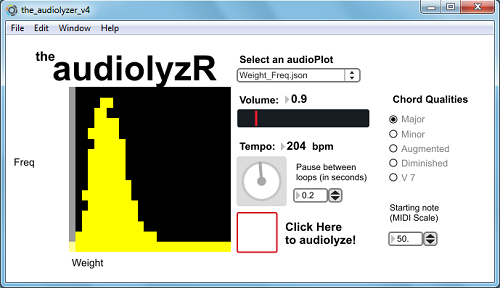Update (5/15/2014): I just realized audiolyzR is publicly available on CRAN. See also co-creator Jesse Garrison’s audiolyzR page.
In his talk “Give Your Data A Listen” at last summer’s useR! 2012 conference, Eric Stone presented joint work with Jesse Garrison on audiolyzR, an R package for “data sonification.” I thought this was a nifty and well-executed idea. Since I haven’t seen Eric and Jesse post any demos online yet, I’d like to share a summary and video clip here, so that I can point to them whenever I describe audiolyzR to other folks.

In August I invited Eric to my workplace to speak, and he gave us a great talk including demos of features added since the useR session. Here’s the post-event summary:
Eric Stone, a PhD student at Temple University, presented his co-authored work with Jesse Garisson on “data sonification”: using sound (other than speech) to visualize a dataset.
Eric demonstrated audiolizations of scatterplots and histograms using the statistical software R and the audio toolkit Max/MSP, as well as his ongoing research on time-series line plots. The software shows a visual display of the data and then plays an audio version, with the x-axis mapped to time and the y-axis to pitch. For instance, a positively-correlated scatterplot sounds like rising scales or arpeggios. Other variables are represented by timbre, volume, etc. to distinguish them. The analyst can also tweak the tempo and other settings while listening to the data repeatedly to help outliers stand out more clearly. A few training examples helped the audience to learn how to listen to these audiolizations and identify these outliers.
Eric believes that, even if the audiolization itself is no clearer than a visual plot, activating multiple cortices in the brain makes the analyst more attuned to the data. As a musician since childhood, he succeeded in making the results sound pleasant so that they do not wear out the listener.
The software will soon be released as an R package and linked to RExcel to expand its reach to Excel users. Future work includes: 1) supporting more data structures and more layers of data in the same audiolization; 2) testing the software with visually impaired users as a tool for accessibility; and 3) developing ways to embed the audiolizations into a website.
Eric suggested that he can imagine someone using this as part of an information dashboard or for reviewing a zillion different data views in a row, while multi-tasking: Just set it to loop through each slice of the data while you work on something else. Your ears will alert you when you hit a data slice that’s unusual and worth investigating further.
Eric has kindly sent me a version of the package, and below I demonstrate a few examples using NHANES data:
I’ve asked Eric if there’s a public release coming anytime soon, but it may be a while:
I am nearly ready to release it, but it’s one of those situations where my advisor will come up with “just one more thing” to add, so, you know, it might be a while.. Anyway, if people are interested I can provide them with the software and everything. Just let me know if anyone is.
If you want to get in touch with Eric, his contact info is in the useR talk abstract linked at the top.
On a very-loosely-related note, consider also John Cook’s post on measuring evidence in decibels. Someday I’d like to re-read this after I’ve had my morning coffee and think about if there’s any useful way to turn this metaphor into literal sonic hypothesis testing.

Thanks for post on R Bloggers.
I’m comparing batches of time series data and audio would be a fabulous
adjunct to the methods being adopted.
Regards,
Tony
Thanks, Tony. Eric showed us his time series line plots in progress, but there was some work to be done before he was ready to release them.
The similarity between this work and the fictional product “Anthem” in Douglas Adams’ book _Dirk Gently’s Holistic Detective Agency_ is pretty remarkable. 🙂